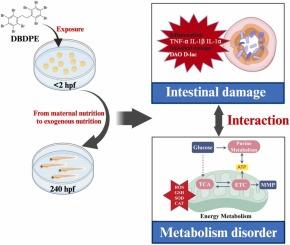十溴二苯乙烷对斑马鱼模型肠道健康和代谢的有害影响:在母体营养向外源营养过渡期间
IF 11.3
1区 环境科学与生态学
Q1 ENGINEERING, ENVIRONMENTAL
引用次数: 0
摘要
新型溴化阻燃剂十溴联苯乙烷(DBDPE)被认为是生物系统中代谢过程的干扰物。然而,DBDPE诱导代谢紊乱的具体机制尚不清楚,特别是在关键发育阶段,如从母体营养向外源营养的转变。在这项研究中,斑马鱼胚胎暴露在浓度为50-400 μg/L的DBDPE中,为期10天。组织病理学分析显示,暴露于DBDPE导致肠道结构改变,导致功能障碍和炎症。16S rRNA测序结果显示,DBDPE改变了肠道菌群组成,特别是影响了引起肠道疾病的黄杆菌和气单胞菌等细菌属的数量。此外,一项代谢组学研究表明,主要在嘌呤代谢、ABC转运蛋白和氧化磷酸化中起作用的代谢物发生了变化。值得注意的是,MetOrigin分析揭示了肠道细菌(如气单胞菌和黄杆菌)和与嘌呤代谢途径相关的代谢物(如肌苷和次黄嘌呤)之间的有趣联系。生物标志物分析证实了这些结果。总的来说,这些发现表明,在从母体营养过渡到外源营养的斑马鱼幼虫中,DBDPE的毒性作用可能与其对肠道健康的有害影响有关,从而破坏能量代谢过程,特别是嘌呤代谢。本文章由计算机程序翻译,如有差异,请以英文原文为准。

Deleterious effects of decabromodiphenyl ethane on intestinal health and metabolism in zebrafish model: During the transition from maternal nutrition to exogenous nutrition
The novel brominated flame retardant, decabromodiphenyl ethane (DBDPE), is acknowledged as a disruptor of metabolic processes in biological systems. However, the specific mechanisms by which DBDPE induces metabolic disorders remain unclear, particularly during critical developmental phases, such as the transition from maternal to exogenous nutrition. In this study, zebrafish embryos were exposed to DBDPE at concentrations of 50–400 μg/L over a crucial 10-day period. Histopathological analysis revealed that exposure to DBDPE resulted in intestine structure alterations, leading to dysfunction and inflammation. Sequencing of 16S rRNA revealed that DBDPE altered the gut microbiota composition, specifically affecting the numbers of bacterial genera like Flavobacterium and Aeromonas, which cause intestinal disease. In addition, a metabolomic investigation indicated changes in metabolites mainly functioning in purine metabolism, ABC transporter, and oxidative phosphorylation. Notably, MetOrigin analysis uncovered an intriguing connection between gut bacteria (e.g., Aeromonas and Flavobacterium) and metabolites (e.g., inosine and hypoxanthine) associated with the purine metabolism pathway. Biomarker analysis corroborated these results. Overall, these findings indicated that in zebrafish larvae transitioning from maternal to exogenous nutrition, the toxic effects of DBDPE might be related to its detrimental impact on intestinal health, thereby disrupting energy metabolism processes, particularly purine metabolism.
求助全文
通过发布文献求助,成功后即可免费获取论文全文。
去求助
来源期刊

Journal of Hazardous Materials
工程技术-工程:环境
CiteScore
25.40
自引率
5.90%
发文量
3059
审稿时长
58 days
期刊介绍:
The Journal of Hazardous Materials serves as a global platform for promoting cutting-edge research in the field of Environmental Science and Engineering. Our publication features a wide range of articles, including full-length research papers, review articles, and perspectives, with the aim of enhancing our understanding of the dangers and risks associated with various materials concerning public health and the environment. It is important to note that the term "environmental contaminants" refers specifically to substances that pose hazardous effects through contamination, while excluding those that do not have such impacts on the environment or human health. Moreover, we emphasize the distinction between wastes and hazardous materials in order to provide further clarity on the scope of the journal. We have a keen interest in exploring specific compounds and microbial agents that have adverse effects on the environment.
 求助内容:
求助内容: 应助结果提醒方式:
应助结果提醒方式:


